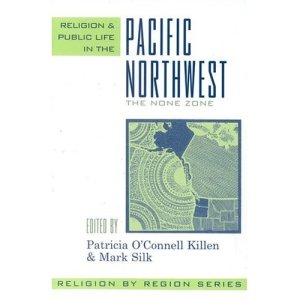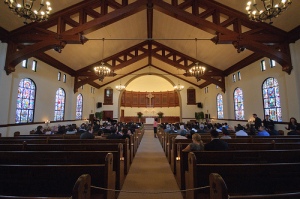Recently I worshipped in two churches that have traditional worship of a high standard: Trinity Episcopal Cathedral, Portland, OR; and Lake Grove Presbyterian Church, Lake Oswego, OR. In this “compare and contrast” of these two traditional services, I want to dispel three myths about traditional worship:
- First, it is repetitive and therefore boring.
- Second, traditional worship is hopelessly mired in the past, disconnected to contemporary life.
- And finally, it tends to make the congregation passive observers, in contrast to the engaging energy of contemporary worship.
The real problem of traditional worship has nothing to do with these features, but rather lies elsewhere – I’ll address this at the end.
What do I mean by “traditional” worship? Traditional worship is characterized by a recurring order of worship (liturgy), with forms of recitation, reflection and music that are vetted by decades – if not centuries – of use by a vast Christian community. For example, my denomination of the United Church of Christ follows an order of worship that varies only slightly among its congregations, the Lord’s Prayer and a Responsive Reading (a psalter) are almost always recited, and the congregation sings time-honored hymns, such as those of Isaac Watts and the Wesleys, as well as listens to the choir sing from the classical repertoire – itself familiar. Thus, traditional worship is repetitious, but its content is so rich that such repetition, rather than being boring, can bring forth new meanings. As a consequence of this repetition, the congregation knows what to do. At its best, traditional worship fuels participation, because the congregation has a deep understanding of what is occurring, and they can thus contribute, through focused minds, confident voices, and even nuanced departures from the expected.
Trinity Episcopal Cathedral (TEC) embodies this participatory power in both its liberal theology and conservative aesthetics. Its pulpit sermons and bulletin announcements suggest a decidedly progressive and participatory exploration of what it means to be Christian (e.g. its bulletin explicitly welcomes “all persons regardless of ethnicity, sexual orientation. . .or religious background. . .to our Eucharist table”). The participatory nature of its worship is exemplified in the church’s processional, a seemingly endless line of robed choir members, priests with brilliantly colored stoles, fresh-faced teen-aged acolytes and aged deacons both dressed in albs, and lay readers in suits and dresses– practically a village parade. The Bible particularly is honored in this procession, carried aloft with special flourishes – a powerful affirmation of its traditional authority. And, when the Gospel lesson is read from its pages, the large, ceremonial Bible is brought down into the center aisle of the congregation by robed bearers, held open by a robed participant and flanked by another bearing a tall, brass standard topped by a cross. Yet the sermon that follows is decidedly modern, citing contemporary poetry as much as the Bible, and the preacher is a female priest – modern moves, both. TEC worships in a sanctuary of Gothic and Romanesque features, graced with massive wood arches, and a brilliant Rose window flanked by a soaring roster of organ pipes.  The service follows the Book of Common Prayer whose lineage dates back to 1662, and the choir and congregational music are traditional. One Sunday I visited the congregation a modern hymn was programmed — “Come Sunday,” by Duke Ellington. But even this bluesy hymn of longing was executed in a traditional style, with strict rhythms and declarative phrasing.
The service follows the Book of Common Prayer whose lineage dates back to 1662, and the choir and congregational music are traditional. One Sunday I visited the congregation a modern hymn was programmed — “Come Sunday,” by Duke Ellington. But even this bluesy hymn of longing was executed in a traditional style, with strict rhythms and declarative phrasing.
Lake Grove Presbyterian’s (LGP) shares many of the features and forms of excellence found at TEC: imposing pipe organ, splendid choir, articulate worship leaders, beautiful sanctuary. LGP is decidedly more conservative, theologically, than TEC or your typical Presbyterian church (that is, those of the PC-USA, the most liberal of the nine Presbyterian denominations in America (http://en.wikipedia.org/wiki/File:Connection2_900.jpg). Indeed, one Sunday morning LGP’s Senior Pastor, Rev. Robert Sanders, briefly but pointedly mentioned the uncomfortable fit of his conservative congregation within the liberal spectrum of the PC-USA.
Thus, tradition seems to stream through almost every symbolic vein of worship at LGP – liturgy, music, theology. But there are small, notable exceptions to LGP’s traditional worship. The choir wears the uniform of contemporary choirs – everyone in black clothing, not robed. Rev. Sanders shares worship leadership with a female colleague, Rev. Libby Boatwright, suggesting a modern sensibility. (Yes, some traditional/conservative churches have long ordained women, particularly Foursquare Gospel churches, but their numbers are still few enough that Rev. Boatwright’s presence is novel.) And one Sunday the pastors “laid hands” upon a team of parishioners, about to embark on a missionary-service trip to Africa – a modern form of church life. This was a memorable moment, the team gathered at the front of the sanctuary with heads bowed, receiving the pastors’ hands upon their shoulders in blessing and palpable love. One final and important note of modernity: LGP’s sanctuary is a modern, stream-lined vault paneled in gleaming wood, illumined by one tall floor-to-ceiling panel of glass that projects natural light and vitality across the faces of the choir.  One of the loveliest features of this space are the many small stained glass windows randomly scattered on the walls by the pews, glowing like tiny jewels.
One of the loveliest features of this space are the many small stained glass windows randomly scattered on the walls by the pews, glowing like tiny jewels.
Thus, the problem with traditional worship is not repetitious boredom, irrelevance to contemporary application or the passivity of the congregation. Rather, the danger of traditional worship is in its excellence, its mastery of the forms of movement, music, preaching and prayer. This danger is that of seeming “sealed up.” Lifeless in perfection, impersonal in exactitude, and, in its own human mastery of the arts of worship, too-exact worship can seem insulated from the disruptive presence of God. It is difficult to explain, yet performers and critics do speak of the nemesis of a too-exact performance. Recently the New York Times Science section featured an insightful article http://www.nytimes.com/2011/04/19/science/19brain.html?_r=1&ref=science, where scientists actually measured the brain activity of audience members, listening to performances with perfect execution of notes and rhythm. They found that such performances failed to excite the brain’s centers for empathy and kinesthetic response. In this same article accomplished musicians spoke about the necessity of incorporating personal weakness in one’s artistic style, and how, without an intuitive responsiveness to the vagaries of an instrument, the audience, and the music, performance becomes lifeless. Here artistic excellence must yield to expressive “weakness,” bringing connection with the moment and the audience.
Traditional worship provides us with tested formulas for profoundly affecting worship, but these formulas can become formulaic, if followed without responsiveness not only to the spirit of the moment, but, as we can say in this Christian context, responsiveness to the Holy Spirit.
Is there “sealed up” worship at Trinity Episcopal and Lake Grove Pres’? Certainly there are “sealed up” moments, but there is enough spontaneity, human warmth, humor and occasional vulnerability in these congregation’s worship services to dispel the plastic perfection that sometimes threatens. Artistically, such perfection is to be avoided. How much more so, theologically! These congregations believe in a God who is both perfect and broken on the cross, a God who is manifested both by order and the disruption of Pentecost. To balance these faces of God requires an aesthetic balance between human mastery of the arts of worship, and submission to the Holy Spirit in worship.











